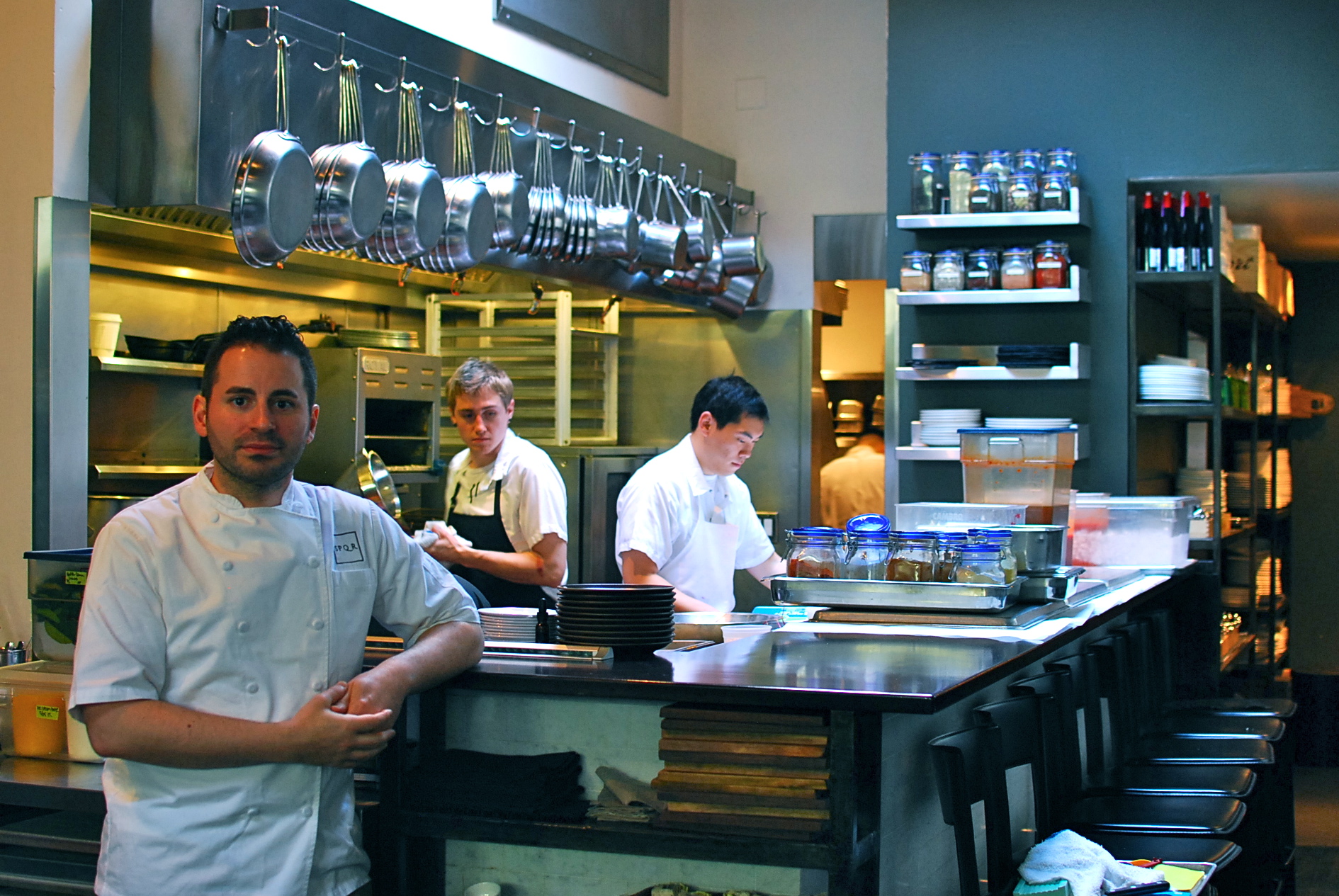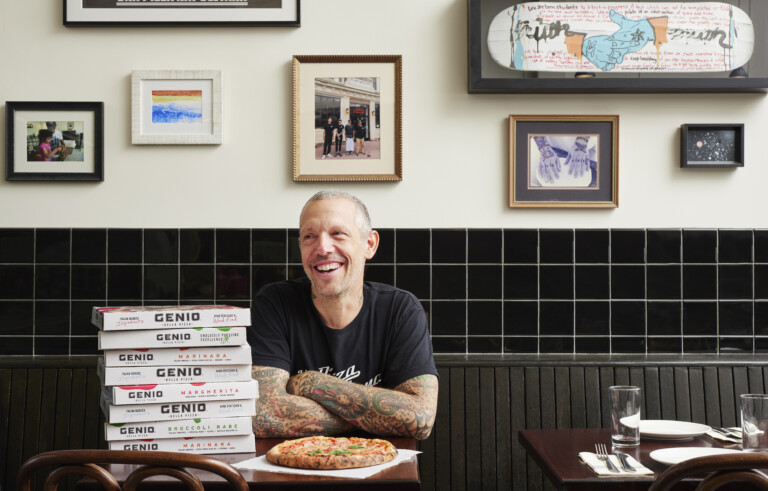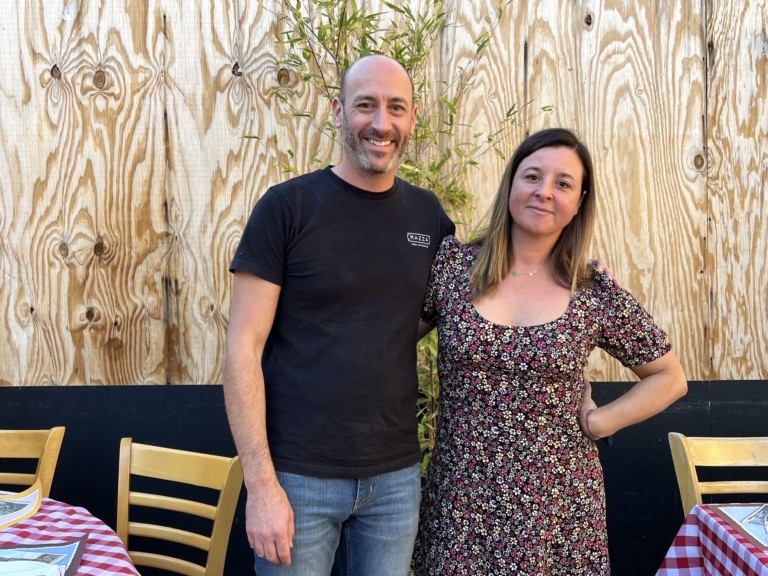Matthew Accarrino grew up in New Jersey and competed as a cyclist before a devastating leg injury incapacitated him. While he was recovering, television (and Emeril in particular) provided a welcome distraction. Emeril proved to be both therapeutic and inspirational. Accarrino attended CIA and worked for celebrated chefs like Rick Moonen (Oceana), Thomas Keller (Per Se) and Tom Colicchio (Craft) before assuming control of the SPQR kitchen in San Francisco. Clearly, people are responding to his cooking. After all, Accarrino is the 2013 choice for Food & Wine People’s Best New Chef: California. On February 7, I met Accarrino at SPQR prior to service, where he shared insights on subjects like inspiration and authenticity.
Did you always plan to become a chef, or did you consider other careers?
I’ve always loved food and always loved cooking, as far back as I can remember, but there was a time when I wanted to be a professional cyclist. Being that I had to control a lot of what I was eating in my diet at that time, I was doing a lot of my own cooking, and I really had a tremendously traumatic experience, where I had a bone tumor that was benign but shattered my right leg. For the better part of two and a half years, I was unable to walk and had to learn to walk again and had to go through physical therapy and a couple surgeries. It was a birth defect that nobody knew about, that you wouldn’t know about until that thing happened. The older I got, the bigger that tumor got, because my femur got longer. So laying in bed all that time, watching too much Emeril Lagasse, Julia Child, Jacques Pepin, really piqued my interest in this idea of being a cook for a living. Really, laying in bed and not being able to go anywhere, you don’t really have too much more to look forward to than your next meal. It definitely piqued my interest and started to center my world around thinking about food and how amazing cooking could be. After that, I ended up in the kitchen of Emeril Lagasse. I wrote him a letter and he took me into his kitchen down in New Orleans. I did a little stage there, and from there and it naturally evolved. It was always one of those things where everywhere I went, people said, “You’re pretty good at this. If you ever apply yourself, you can probably make a living out of it.” I sort of kept following that path, and it’s led me all the way to where I am today.
What do you remember about that first night in Emeril’s kitchen?
Making banana cream pies with Mr. B. I don’t know if he’s still around, but those are the best things ever. It was amazing. It was a vibrant, busy kitchen. There was a lot of stuff going on. It felt very exciting, and one of the great things about cooking for a living, there are recipes that may take days – a braised item, or you take a whole animal and turn it into charcuterie – but at some point, in every day, there’s some moment of instant gratification because I’m able to make something and see it complete. Whereas I’m an artist and I’m making a mural, and the mural’s going to take me two years to complete, well, you have to go work every day, and work on this thing. It evolves and it takes shape, and eventually it becomes a product you can look at, and maybe it lasts longer than anything we do in the kitchen, because when it’s done, it can hang somewhere. You can look at it. But that instant gratification is not really there, because it takes that time. There’s something about being a chef and that interaction that’s unlike any other business. There’s part craftsmanship, part art, there’s lot of creativity in our field, but there’s also that customer interaction and the sense of hospitality, and being able to interact with people, that I think is a really wonderful part of cooking for a living.
How much do you enjoy having an open kitchen?
That’s funny, because at first I hated it. Not hated it, but hated the idea of it, because I’m a very focused cook and really wanted to have my head down and be interested in what’s going on. I saw having people all around you as a distraction, especially since people want to talk to you and the guests want to interact with you. As time’s gone on, I’ve realized that proximity for me, to understand what people want and how to make people happier, is important. It allows us to be very intuitive and very responsive to what guests are seeing and tasting and experiencing. It’s become a very important part of who I am at this point. I always try to reconcile, every time I think about what the next project will be like, what my next kitchen will be like, disconnecting from that proximity will make me as nervous as the original connection to that proximity was. I don’t know how will it define me, and I’m not saying I’m not open to having a kitchen behind some closed doors, but it’s definitely made me evolve.
How long have you been living in San Francisco?
It’s been about three and a half years, and I realized after leaving [Craft Los Angeles], I was either going to go back to New York, and I had some magnetism to the Bay Area. I had some so many things that I was using – I had a full-time forager [Kerry Clasby] who was working for me in L.A. – I realized a lot of things I was using – where is Marin Roots Farm? Where is County Line? Where is Star Route? Where are these places? Every week, she would come up here and gather things from the markets here and even go wild foraging and bring down big bushels of wild fennel. They would drive all the things down to us in L.A. So it piqued my interest in coming up here. Another reason I was interested in coming to the Bay Area is because when I worked at Per Se for Thomas Keller, I was the only guy on the management team that had not worked in California. At that time, Tim Hollingsworth, who at that time was a sous chef at the Laundry, and Corey Lee, who’s now at Benu, Chris L’Hommedieu, who had been at Prospect recently, all these guys were there as sous chefs and helping out, and other guys like Ryan Fanter, who I think is still at Barndiva up north. All these guys came out and said, “This artichoke is good, but you should see the artichoke we get in Yountville.” “This is good, but you should see what we get in the Bay Area.” You don’t want to hear that stuff. That’s kind of annoying, being a chef who’s trained and worked most of your career in New York. But it definitely planted a seed. So by the time the opportunity came to come here, those were things that were going around in my head. “If I can move closer to the product, that will make my job easier.” The reality is, it does.
How has moving to San Francisco made your job easier or more interesting?
I think there’s a great culture of dining. This is really a great dining city. We’re lucky here that people love food in this town so much. If you open a restaurant, and you make good food, people come. I am in my mid 30’s, and I see it among my group of peers, that are all about the same age. There are a lot of people my age that have great restaurants in this town. There are a lot of people, and there are a lot of great iconic restaurants like Quince, Coi, The French Laundry, and Gary Danko – those restaurants define what the Bay Area is about, which is sort of product meets innovation.
When you came to SPQR, there was already a definition of the restaurant. Was that a challenge?
That was almost an unexpected challenge. Really, coming here, I knew next to nothing about the restaurant, and only got connected with the owners, and spent some time with the owners and thought, “These people are really great people.” A lot of things in life depend more on character – to me at least – depend more on character than sort of actuality. You can be in a wonderful, thriving business with people that you hate. Or you can be in business with people you really like to be around and make the business thriving based on that. It’s sort of two different approaches. I was really looking for people I could work with that would allow me to express my culinary vision and would allow me to move forward with support. That’s what I found in them, and then walking into the restaurant, I was like, “Oh, this is small plates. A lot of the food was kind of fried.” It had been more of a white hot restaurant than I realized walking in the door. The chef before me, Nate Appleman, had won two major awards the year before. So in a sense, it was big shoes to fill, but in another sense, I wasn’t going to continue to do what was being done here, almost in any way. Making that transition, it was the first time I’d taken over a restaurant and transitioned it to being my restaurant, in my career. It was a bigger challenge than I thought because people have preconceived notions. For the first two years, people would walk in the door and go, “Oh, those fried Brussels sprouts. We want to have those.” Because that was a dish you had to have before you die. Since then, that’s fallen away, and we never hear that anymore.
You talk about culinary vision. At what point did that come into focus for you? And how far along is that evolution?
This is really the first restaurant where I say I’m cooking Italian food. But in America, we have this tradition of cooking a parody of someone else’s food. Someone makes Spanish food, you’re in New York. I’m going to make Italian food. I’m in California. I’m not in Italy. If you go to Italy and eat food in Italy, that’s probably Italian food, because you’re in Italy. I’m an American who cooks, as a connection to my heritage, food that feels Italian. But it’s probably really American. To me, the biggest thing that defines the Italian idiom of cooking is the tradition of the pasta or starch course. We do a lot of things that focus on pasta in this restaurant, because it works for us. We have a small kitchen, small space, and I like to honor the Italian tradition of the starch course. That’s where that comes from, but for me, I’m cooking as an American who was trained by a lot of people who were trained in French techniques and went to school. Going to school, I was framed in French. We learned to make roux, we learned to make the mother sauces. If you’re cooking from a purely Italian aesthetic, nobody’s really teaching you that stuff. I have this blend, and that blend, along with that American idea of innovation and creativity, is where my cooking style’s coming from. It’s always been there, but when you become an executive chef, and you’re the only one making the menu, as the years progress, your style is always there, but it’s like an onion. Every year, you peel another layer off and get more to the core of what it’s about. Every year, I get closer to refining that vision, and distilling it into its essence. It becomes more powerful.
It seems this notion of culinary authenticity has come to the forefront these days. The idea of Italian food, is it only authentic in Italy? Or does it even matter?
I almost think that it doesn’t. I don’t think that buying a bunch of ingredients from Italy and putting them together in a way that sounds Italian makes my food more Italian. You’re sort of paraphrasing or making a parody or making a facsimile of something. For instance, my family’s from Puglia, and they have a grano arso, a burnt flour. Traditionally, it was made after the harvest. They would burn the wheat fields to knock everything down and prepare it for the following season. The peasants would then go into the fields and take all the last little bits of the wheat because they were all pour, and they were hungry, they would grind it up and make flour. They would use it for bread. They would make pasta. That’s where that tradition came from. Now, even in Italy, nobody does that. And not only doesn’t anybody do that, and there are no peasants running around gathering flour, but that artisanally made flour – and basically what they would do is burn the whole grain and then grind it into flour – I had some chefs from Puglia here the other night and they were explaining to me that even that is food for the rich people in Italy now, and not food for the poor. So it’s sort of flipped. We do a pasta like that here, and I’ve always done it by cooking the flour in the oven. Recently, we’ve switched to that idea of cooking the whole grain and burning it. I’m actually using a blowtorch to burn it, because you need fire. I’m sort of toying with the idea of running down to A16, which is our sister restaurant, and putting the whole grains into their wood oven, so I can burn them, rather than turn them into flour here. To me, I’ll be able to get that more authentic flavor out of that, but you could see how much trouble I’m going to go to, just to try and recreate an ingredient or an idea that at one point was something to be forgotten about. It was what the poor were scraping up from the fields, and here we are refining and glamorizing the whole thing. If you start to look at that as that idea of authenticity, authenticity is a concept. Authenticity is something you think about in terms or replicating, but the most authentic way, you’re trying to capture a place in time, or a flavor, or a moment, or an idea, out of its own natural context. That is something very important to be aware of, because I don’t hold on. I always say that I’m inspired by tradition, but not bound to it, because I feel that it’s not right to hold on too tightly to those ideas and worry about how authentic I’m being, when I’m trying to be evocative instead of authentic.
What was the last dish that you created for SPQR, and what was your inspiration?
INTERVIEW CONTINUED ON THE NEXT PAGE









Leave a Comment